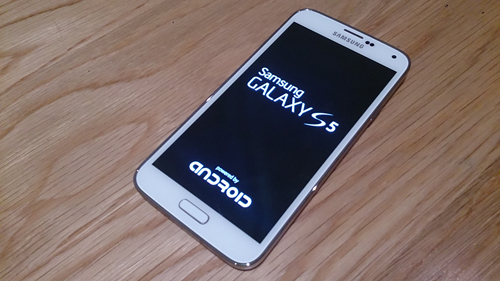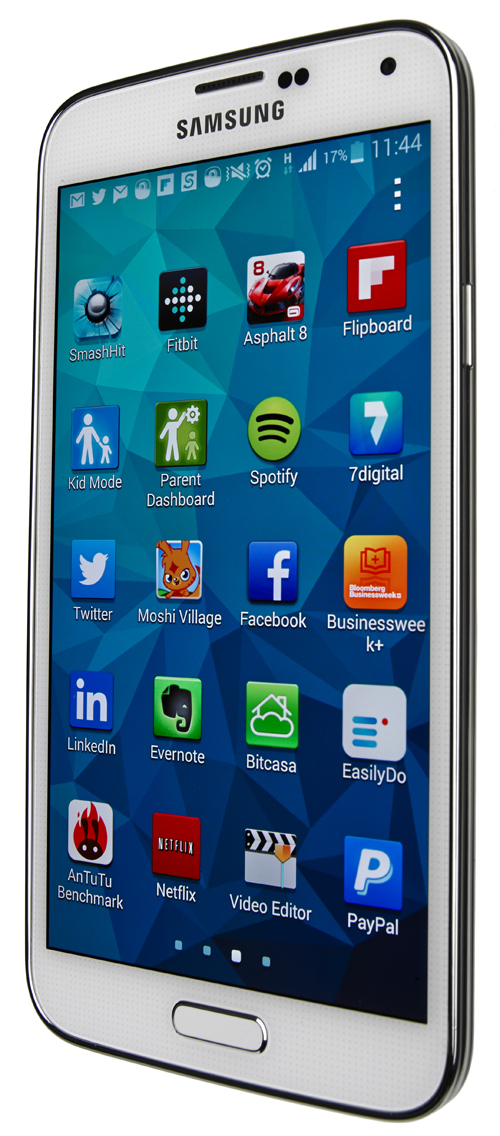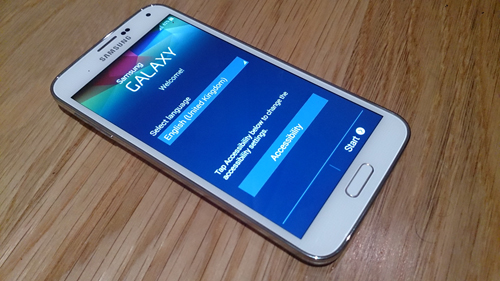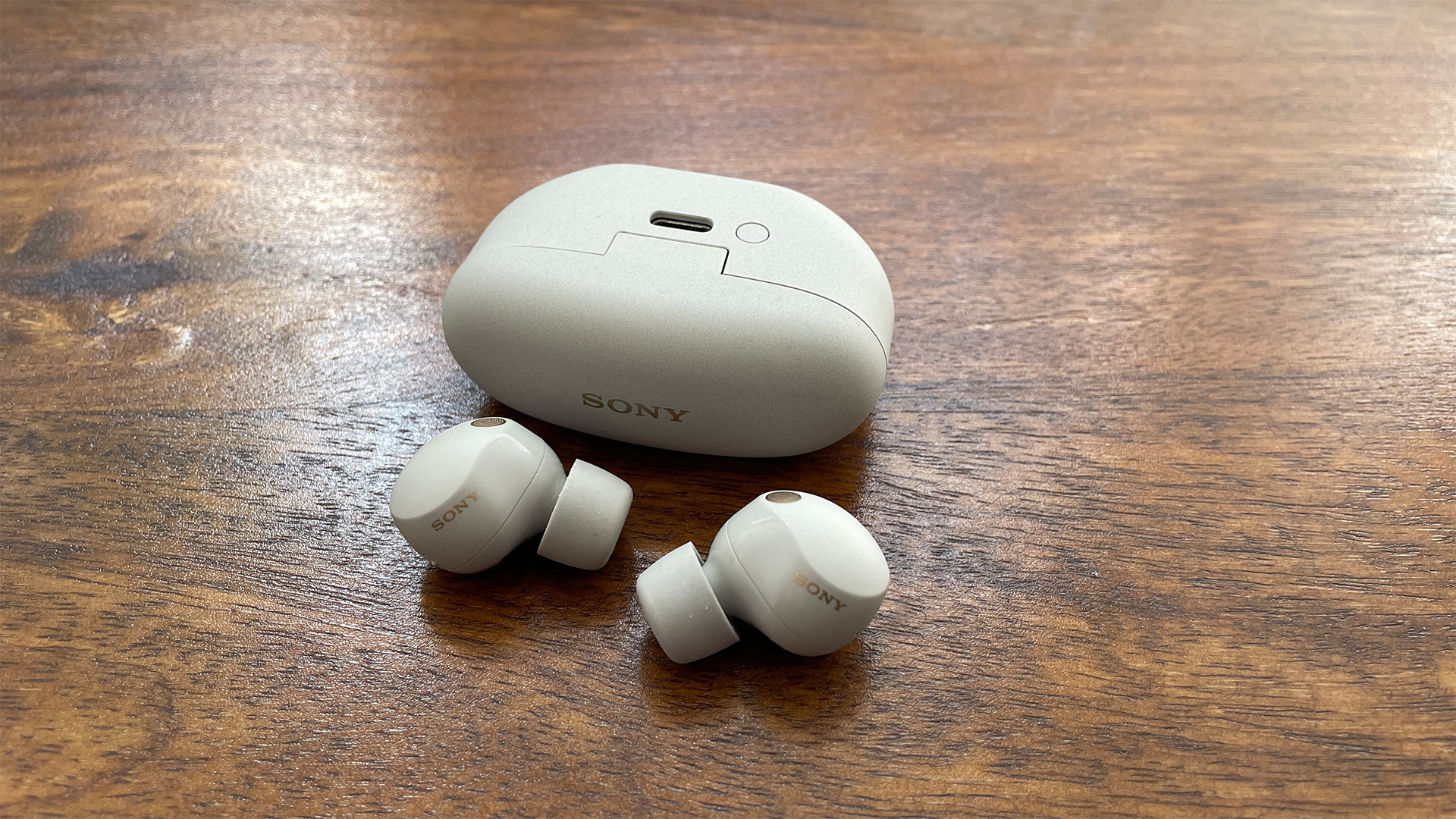What Hi-Fi? Verdict
The S5 is fast, powerful and the slickest Galaxy phone yet: but it’s not the best for audio or video and doesn’t quite have that wow factor
Pros
- +
Fast and powerful
- +
Big, replaceable battery
- +
Colourful video
- +
Quick, decent camera
- +
Eye-catching features
Cons
- -
Average sound
- -
Erratic Finger Sensor
- -
Plastic design
Why you can trust What Hi-Fi?
The Samsung Galaxy S5 is the latest addition to the best-selling smartphone range of all time.
The Galaxy S3 made the line-up famous but the S4 sent the series stratospheric – and the two phones had shifted over 100 million units by the end of last year (2013).
Samsung's S5 will probably be one of this year's best-selling smartphones; the S3 is the world's most popular handset, the S4 proved a worthy successor and this latest flagship phone has a stack of new and improved features.
MORE: Best smartphones 2014
Yet overall it's a mixed bad – impressing and disappointing at the same time.
Design and build
At first glance, you’d be hard-pressed to pick the S5 from the Galaxy line-up. Predictably, it’s a plastic build again, though the back casing now has an artificial leather, perforated finish.
This does improve the feel of the phone and crucially makes it easier to grip and less likely to slip out of your hand or off the sofa. But it's fair to say it still feels notably less luxurious than the best of the premium-priced rivals.
The latest hi-fi, home cinema and tech news, reviews, buying advice and deals, direct to your inbox.
Bucking the trend for ever-slimmer, ever-lighter phones, the Galaxy S5 is actually heavier and thicker than the S4. But not by much: 15g and 0.2mm, respectively and its 8.1mm depth and 145g weight is still thinner and lighter than the Sony Xperia Z2 and HTC One (M8).
These changes are probably to accommodate the bigger screen, which now measures 5.1in on the S5 compared to the 5in display of its predecessor.
This is becoming the norm for the top-tier phones but if you have not used one before, we’d suggest you try before you buy: they’re big.
One new feature is a flap covering the USB connection at the bottom of the phone, part of the ‘ingress protection’: the Galaxy S5, like the Sony Xperia Z2, is dustproof and water-resistant.
According to the IP67 coding, the S5 should be totally protected against dust and “protected against the effect of immersion between 15cm and 1m”. This doesn’t mean it’s 100 per cent waterproof but it does mean you can drop it in the bath.
Overall, the design of the S5 is an effective, albeit minor, evolution.
Specs
The Galaxy S5 screen may be a smidgen larger than the S4 – but the remaining features stay the same. It’s the same Super AMOLED display and the same 1920 x 1080, full HD resolution.
Rumours of a 2K screen were unfounded. A solid 432 pixels per inch puts the new S5 ahead of the competition if we’re totting up pixels: above the LG G2 (5.2in, 423ppi) but below the Google Nexus 5 (5in, 445ppi). The iPhone 5s’s smaller screen finds it some way behind.
Other aspects of the Galaxy S5 spec sheet are more impressive. There’s the very latest quad-core, 2.5 GHz Qualcomm Snapdragon 801 processor chipset, alongside 2GB RAM. Complaints about lag shouldn’t be an issue here.
S4 speed issues were put down to Samsung’s TouchWiz operating system and the pre-loaded proprietary Samsung apps, so we’re happy to report noticeable improvements here.
Software and interface
The Galaxy S5 software uses the latest Android 4.4 KitKat OS, together – as is customary – with Samsung’s own TouchWiz UI overlay.
The good news, for those who prefer an untouched version of the Android software, is that Samsung has noticeably toned-down the look and feel of TouchWiz and stripped back the amount of ‘bloatware’ loaded on the phone.
Well, Samsung has hidden it at least. Samsung has taken a page out of Google’s book and grouped its proprietary apps together in one folder.
The S5 gives you the option of leafing through recommended Samsung apps – the Galaxy Essentials widget houses WatchON, S Note, Samsung Gear Manager and more – rather than suggesting it more forcefully on previous models.
The overall feel of the S5 interface and software follows a similar vein: fewer ‘shouty’ apps and widgets, calmer colours, more space, a more fluid, relaxed feel using the phone.
The ongoing Apple vs Samsung legal battle revealed Samsung’s perception of the average Apple customer as being relaxed and laid back – and it feels like they are trying to replicate this vision.
Navigating the Galaxy S5 is also made more familiar to anyone new to the Galaxy range with a change to the main controls.
The main, clicking, plastic home key remains but the touch controls either side are now a ‘return’ on the right and a ‘recent’ key, which shows you all the open apps, on the left.
This layout makes the Galaxy keys consistent with the generic Android experience, whereas before, this had been a Menu button on other Galaxy phones.
This selection of touch keys makes most sense – which way round will come down to preference and familiarity.
The phone certainly feels much more intuitive, even if the clunky, click of the home button does take the shine off having a premium smartphone in your hand.
Features
The headline-grabbing new feature on the S5 is arguably the Finger Scanner.
Reintroduced to the public conscious by the iPhone 5s (having actually been a feature on the Motorola Atrix back in 2011), Samsung has somewhat predictably followed suit.
While Apple’s sensor is a case of holding your print over the sensor in the home button, here you must swipe from the foot of the screen down over the home button.
It works but it’s erratic. Due to the size of the phone, it’s hard to do the action one-handed.
The S5 prompts us to swipe the whole fingerprint, which really requires two hands. And unlocking your phone using two hands is a little impractical for every day use.

It is possible to hold the phone in one hand and do a sideways swipe of the thumb which the registration process accepts, but this can then be hard to replicate, meaning you will be prompted for a whole finger swipe when you come to try and unlock your phone.
Even a perfectly placed finger must be moved slowly and deliberately to please the sensor. Either way, it’s a work in progress. The iPhone 5s fingerprint sensor isn’t perfect either but it’s a better first effort.
Also new is a heart-rate monitor, part of the new look S Health app. A little sensor next to the rear-facing camera lens can record your heart-rate as part of a wider suite of exercise tools, including a pedometer and other fitness trackers.
Designed to work in tandem with Samsung’s smartwatch line-up, such as the Gear Fit, it’s certainly a slick app and the heart-rate tool is a useful function that doubles as a neat show-off feature to open-mouthed pals (although there are generic heart sensor apps on the market).
It’s almost easy to forget some of the features we already take for granted on flagship phones in 2014, but gesture and voice controls such as Air View – which allows you to preview images and text by hovering a finger over the screen – and Smart Stay, which keeps the display on as long as it detects you’re looking at it, are kept in place from the Galaxy S4.
Clever features, they already seem part of the furniture of your phone (not least as other brands have similar models); albeit furniture that we find ourselves not using very often.
Picture

As we mentioned already, the Galaxy S5 screen is almost identical to its predecessor, only adding a fraction more screen size but keeping the same resolution and Super AMOLED display technology.
We’ve come to expect vivid, dynamic pictures, when watching videos on a Galaxy smartphone, but they haven’t delivered the definite article when it comes to detail or accuracy.
The S5 is an improvement on the S4 but still follows a similar suit and – while again being impressive with certain content – falls short in other areas when put up against its peers.
There’s a new Adapt Display mode that promises to automatically optimise the S5’s screen according to the app you have open.
Adjustments to colour range, saturation and sharpness will be made automatically when you’re in the gallery, camera, internet, video, smart remote and Google Play Books apps, but it won’t kick-in on most third party apps.

There’s a choice of four other picture modes: Dynamic, Standard, Professional photo and Cinema.
It was a toss-up between the more typical Samsung-feeling Standard mode and the more relaxed, refined Cinema mode for us, though Adapt seemed to work well enough if you don’t mind giving up control.
As you’d expect from an AMOLED screen, black levels are impressive. The S5 is capable of dark but detailed blacks, ensuring the S5 picks out details and edges in gloomy scenes that most other smartphones won’t manage.
Bright splashes of colour are reproduced with punch, while motion is handled comfortably.
All told, it’s a very watchable picture that’s capable of impressive performance in isolation.
It’s testament to the quality of the competition that in A/B comparisons we can find faults: at times colours can still be a little over-saturated, struggling to resist making naturally lit TV and film scenes look a little unreal.
Rivals deliver a more refined, relaxed presentation, which often is more faithful and immersive.
Sound quality
We were disappointed by the sound quality of the Samsung Galaxy S4, preferring the likes of the Sony Xperia Z and HTC One, not to mention the class-leading iPhone 5. With those rivals having evolved for the better, we need to hear a jump in class from the new S5 on audio performance.
Sadly, the Galaxy S5 still falls short. Listening to a WAV of Jill Scott’s Do You Remember, the Galaxy S5 – using a pair of reference AKG K550 headphones – struggles to capture our imagination, meandering along nicely enough but lacking the detail and dynamics afforded the same track by rival phones from Apple, HTC and Sony.
Something a little more upbeat, Nitin Sawhney’s classic Prophesy, doesn’t have the punch we’d expect or enough space for the instruments.
There’s no brightness, nor do voices sound closed or muffled. It’s an average performance from a premium mobile phone.
Android’s stock-list of supported file formats is fairly thorough and includes FLAC and WAV for higher quality music, but while the Galaxy Note 3 and the LG G2 brought high-res audio capability to the table, there’s no such support here.
The Galaxy S5, like most phones, has a range of equalizer options, even going to the trouble of allowing you to flick on ‘Tube Amp’ mode (that’s valves, to you and me) to ‘simulate the timbre of a Tube amp’.
This proves to equal dialing up the warmth and somewhat muffling the treble as a result.
Calls and battery
The battery is something Samsung has improved for this year’s flagship: the Galaxy S5 has a 2800 mAh battery as opposed to the 2500mAh in its predecessor.
There’s also an Ultra Saving Mode so you can get even more juice (though this, like many apps on the market, simply involves turning off much of the functionality).
In normal use you should get a full day of battery life, and we’re happier with the S5’s lifespan from daily use than most other phones on the market.
While you may have to switch off some of the battery-sapping features and notifications to eek out a full day of heavy usage, this is fairly standard for feature-packed phones.
The good news for those power users, or anyone else happy to get their hands dirty, is that the battery is removable, so you can swap it for a bigger one pretty easily. Either way, you’re unlikely to have too many complaints on the power front.
Camera
For many people the camera quality of the smartphone can make all the difference.
Thankfully, the Galaxy S5 is pretty strong in this area, taking lightning quick pictures and delivering bright, punchy images.
Much like the video performance, colours can look a touch over-cooked at times but, similarly, that does give bright reds and lush greens a certain wow factor.
Again, others can deliver more natural hues, and more crucially, deliver more accurate results in lower light.
After Apple’s panorama mode and HTC’s Zoe, Samsung too has upped its game and introduced a staggering amount of features to the cameraphone experience.
The highlight might be 4K video recording, which delivers impressive results, even if very few people will get to see the content in all its glory on a 4K screen any time soon.
Elsewhere, features such as Burst shots (multiple pictures with one press of the button), face detection, image stabilization, selective focus, HDR mode and a wealth of editing effects are present and correct. There are front- (2-megapixels) and rear-facing (16-megapixels) cameras, as you’d expect.
If a good quality snapper is important to you, then you won’t be disappointed by the Galaxy S5 camera even if it’s not quite the complete all-rounder.
Verdict
Samsung has now moved into Apple’s territory: it has a hugely popular product that will sell well, regardless of the critical reception.
So it’s no surprise the company hasn’t messed about with a winning formula. Evolution rather than revolution is indeed the name of the game, with incremental jumps in performance and a smattering of novel but not game-changing features.
It’s what we expected, and the Galaxy S5 delivers. Just about.
The majority of people who buy the new Galaxy phone will be happy with what they buy, and rightly so.
But for the more discerning buyer and for Android aficionados, the Samsung flagship phone might feel a touch underwhelming.
Eye-catching features don’t quite deliver: the Finger Scanner is a little flakey and the S Health app requires a Smart Watch to really come in to its own, leaving the S5 low on wow factor.
The screen looks great but doesn’t offer a noticeable jump in performance, while sound quality is fine but comfortably beaten by the best smartphones on the market.
And while the design tweaks are welcome, they’re again not a giant leap, meaning those who knock the plastic chassis will still have cause to grumble.
The biggest improvement is the interface, with the TouchWiz overlay at its least intrusive and most intuitive. If you love the Samsung experience, this will surely be your favourite take on it yet.
But is that enough to convince new users to jump ship from HTC, Sony or even Apple? Or conversely, stop them being tempted away? We’re not so sure.
The Samsung Galaxy range is hugely successful and we’ve no doubt the Galaxy S5 will continue the tradition.
We just wish we could be a little more enthusiastic about the latest addition to the family.
MORE: Best smartphones to buy in 2014
MORE: Android smartphone and tablet reviews
Follow whathifi.com on Twitter
What Hi-Fi?, founded in 1976, is the world's leading independent guide to buying and owning hi-fi and home entertainment products. Our comprehensive tests help you buy the very best for your money, with our advice sections giving you step-by-step information on how to get even more from your music and movies. Everything is tested by our dedicated team of in-house reviewers in our custom-built test rooms in London, Reading and Bath. Our coveted five-star rating and Awards are recognised all over the world as the ultimate seal of approval, so you can buy with absolute confidence.


